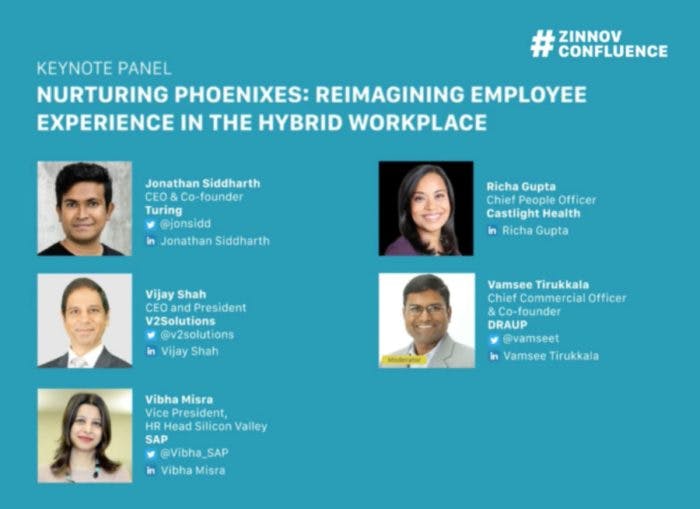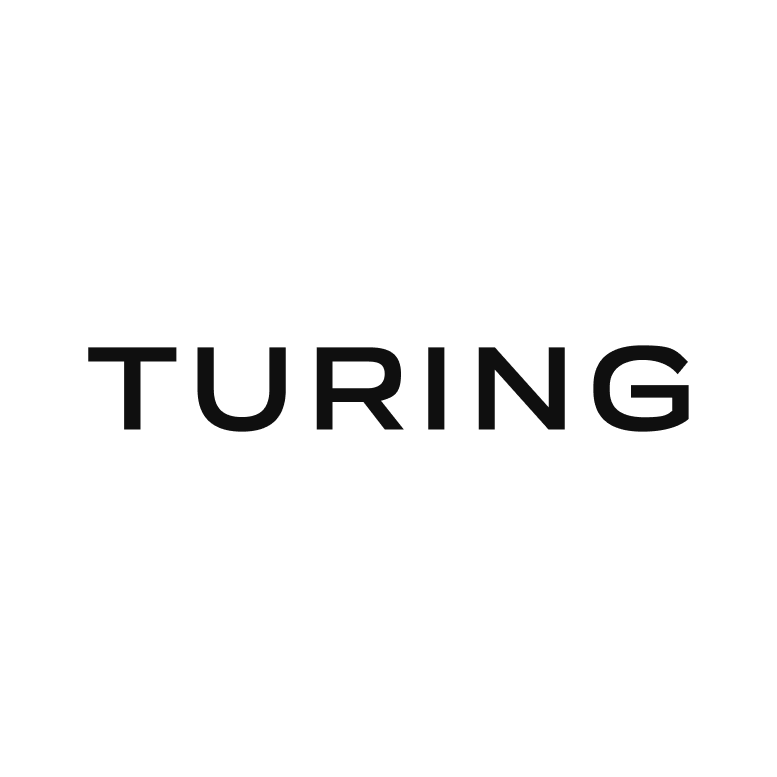Jonathan joined expert panelists to discuss the rise of remote work, strategies and challenges of hiring remote workers, and the need for organizational transparency.
Jonathan Siddharth, CEO, and co-founder of Turing, joined a panel of executive leaders for Zinnov Confluence, Nurturing Phoenixes: Reimagining Employee Experience in the Hybrid Workplace on March 25th, 2021. The entirely virtual edition of Confluence 2021 – US Chapter highlighted how leaders should adapt to disruptions shaped by technology and talent in the post-pandemic new normal.
Delving into the intricacies of employee engagement and mental well-being, sustaining a positive mindset, and providing timely assistance, the session showcased how organizations rose above the challenges posed by the pandemic and embraced remote and hybrid work environments.
Along with Jonathan, panelists included Vijay Shah, CEO, and President of V2Solutions; Richa Gupta, Chief People Officer at Castlight Health; Vibha Misra, Vice President and Head of HR for SAP Silicon Valley; and Vamsee Tirukkala, Chief Commercial Officer and Co-founder of Draup (Session Chair).

Here are some of the key takeaways from the panel:
The Future of Work is Remote
“The big shift,” Jonathan says, “is going forward, all work will be remote work and all teams will be distributed — even globally distributed — teams. In the new normal, a tremendous amount of work is going to be remote or remote-hybrid.” Jonathan continued, “In the future, the three things that people will have to keep in mind are:
- Mastering asynchronous communication
- Enforcing consistency in how teams communicate
- Having a great culture
“These are three things to double down on in this new normal,” Jonathan added.
Trends in Employee Management and Engagement
Vibha shared that SAP’s priorities as an organization were employee safety and well-being. Addressing the challenges that her team faced while going remote, she recounted: “One of the challenges for us was community building. With community building, we started going virtual and encouraged people to come together and form teams (to perform various activities together).”
Talking about the unique trends he had observed in terms of employee engagement, Vijay outlined: “(The past year) has been an opportunity for new players to shine in a new light. Discoveries that we would’ve never made have been expedited. Passive individuals have become remarkable leaders.” He further elaborated that as an organization, his company gave precedence to staying calm and not adding to anxiety people were already feeling.
The Need for Organizational Transparency
Vijay stated that the FSAT score i.e. the Family Satisfaction score helped V2Solutions in gauging the overall productivity of the team and measuring their anxiety levels. “We ran a survey where the employees didn’t have a say but the family members had a say on how the employees were doing,” he explained.
Adding to the discourse on maintaining organizational transparency, Jonathan said: “When you’re operating as a remote distributed team, the most important thing is asynchronous communication. At Turing, we have a very detailed onboarding process where we ensure that the person understands the organizational context, the different teams that work together along with the metrics they care about, and the company’s priorities quarter by quarter. We write all of this down and share it with people because we don’t want people to be stuck in Slack silos, where they don’t know what’s happening in other channels.”
Jonathan also accentuated the importance of setting up frequent checkpoints and periodic follow-throughs to maintain transparency, where possible. “I encourage my teams to have in-person meetings where it’s safe to do so. Remote work does not mean you never meet and are always in Zoom. Some of our teams occasionally have socially distanced meetings, if they’re comfortable doing so,” he elaborated.
Trust and Wise Compassion
Further, into the session, the speakers shared views on the best practices that companies should adopt when working remotely. “Communication is key for any successful change management. It’s important to communicate truthfully with the employees and set the right expectations,” observed Vibha. She also underscored the importance of defining organizational behaviors, conducting employee trust surveys, and giving back to society to nurture organizational culture.
Adding to this theme, Richa noted: “The one concept that I have learned and taught my managers (at Castlight Health) is the concept of wise compassion. The economy went through some complex changes and we don’t have a day to skip a beat. We have to keep the work going, and we have to keep the people going. Getting tough things done in a humane way is wise compassion.” She stated that connecting people digitally on common causes was imperative for ensuring healthy communication between teams and individuals.
Hiring remote – Strategies and Challenges
The panelists also discussed principal factors to keep in mind while hiring remote talent. Drawing attention to employers’ proclivity to hire the best in the world, Jonathan shared: “If you’re hiring in a remote-first world it is important to look into countries that have high-quality talent but not enough local opportunity. There is great talent all over the world, you just need to have a data-driven process that can evaluate a really large top of the funnel.”
On the challenges of remote hiring, he stated: “If you’re hiring a great engineer from Sao Paulo, Brazil, you may not see Stanford or Berkeley on their resume. You won’t see Google or Facebook in their work experience. But these may still be great people. Since you cannot filter by resume or LinkedIn profile, you have to assess through light-weight technical tests for screening, which creates a level playing field.”
Jonathan also spoke about the significance of conducting asynchronous tests while evaluating remote candidates. “We find testing to be very fair in terms of elimination of bias. We don’t care what the people look like or sound like, we just care whether they can do the job,” he asserted.
The session left the audience with notable insight on evolving employee experience amidst the pandemic and concluded with an optimistic outlook for a remote-friendly future.
Watch the entire session here.
Want to accelerate your business with AI?
Talk to one of our solutions architects and start innovating with AI-powered talent.



